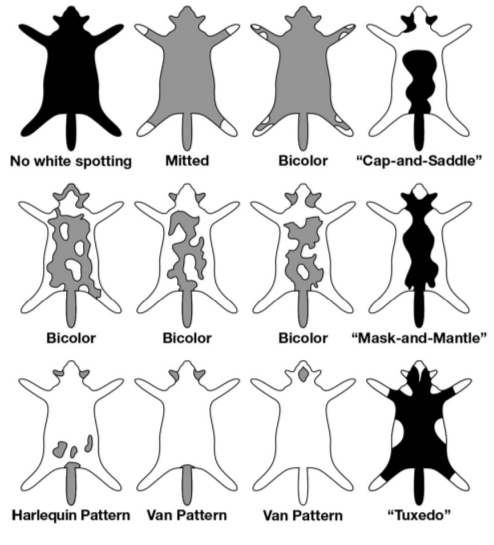
Testing of cats: Locus W
Locus W – white coat colour and white spotting in cats
White colour is generally associated with partial or complete loss of pigmentation with the risk of deafness and iris hypopigmentation. The manifestation of these features depends on the probability of expression of this gene variant as the phenotype – penetrance. In case of complete penetrance, the phenotype (e.g. absence of pigmentation) is expressed in all individuals. If case of incomplete penetrance the relevant phenotype (e.g. deafness, iris hypopigmentation) is expressed only in some individuals. The cats are not the only mammalian species affected with deafness and iris hypopigmentation. This defect occurs in mice, horses and humans as well.
.
Artificial selection in cats led to creation of some phenotypes that differ by the degree of white colour.
- Dominant white, uniform white coat – often accompanied by deafness and iris hypopigmentation.
- White colour in form of variable distribution of white spots on the body.
- White colour restricted to the paws.
.
The white colour can be caused by two loci:
1. Locus C
The white coat colour can be associated with locus C, which involves TYR-gene encoding enzyme tyronase that is necessary for melanin synthesis. Cats with mutated TYR-gene have white colour however their hearing is not affected contrary to cats with mutation in KIT-gene.
2. Locus W
The loss of pigmentation and complete white coat colour and white spotting are caused by retrovirus insertion in KIT – FERV1 gene located in locus W. This mutation can also cause deafness and blue eye colour. In general, white cats with blue iris colour present a classic model for deafness. The inner ear in affected cats shows signs of degeneration of the snail and one of the membranous sacs inside the inner ear labyrinth. The gradual degeneration of the snail starts in the first week after birth. The affected cats completely lack melanocytes in the inner ear. By and large, the retrovirus insertions are a vast source of phenotypic variability. The endogenous retrovirus insertion in KIT-gene has its origin in an accidental infection of a mammalian ancestor by retrovirus that subsequently integrated into the germ line.
.
At the locus W, 4 allelic variants have been found and that W (completely white), wm (much spotted), wl (little spotted) and N (normal). In general, the allelic variants wm and wl are jointly designated ws. For the degree of white pigmentation it is important whether the carrier of the ws-allele is heterozygous or homozygous.

Types of pigmentation patterns (David et al., 2015)
.
Possible genotypes at locus W
W/W – a cat of this genotype will be white, deaf or partially deaf and blue eyed
W/N – the cat will be white, can be healthy, deaf or partially deaf and can have blue irises
W/ws – the cat will be white; can be healthy, deaf or partially deaf
ws/ws – the cat will have normal hearing and its coat will have white spotting with variable distribution of white areas on the body
N/ws - the cat will have normal hearing and its coat will have white spotting with variable distribution of white areas on the body
N/N - the cat will have normal hearing and fully pigmented coat.
.
References:
David, V. A., Menotti-Raymond, M., Wallace, A. C., Roelke, M., Kehler, J., Leighty, R., Eizirik, E., Hannah, S. S., Nelson, G., Schäffer, A. A., Connelly, C. J., O'Brien, S. J. & Ryugo, D. K. (2014). Endogenous retrovirus insertion in the KIT oncogene determines white and white spotting in domestic cats. G3: Genes| Genomes| Genetics, 4(10), 1881-1891.
Frischknecht, M., Jagannathan, V., & Leeb, T. (2015). Whole genome sequencing confirms KIT insertions in a white cat. Animal genetics, 46(1), 98-98.



